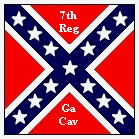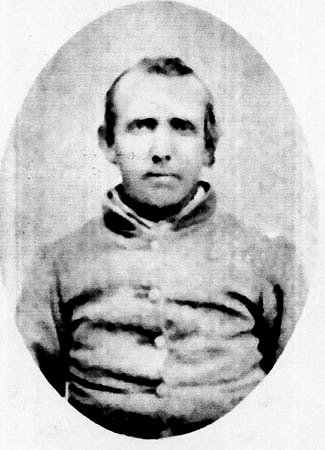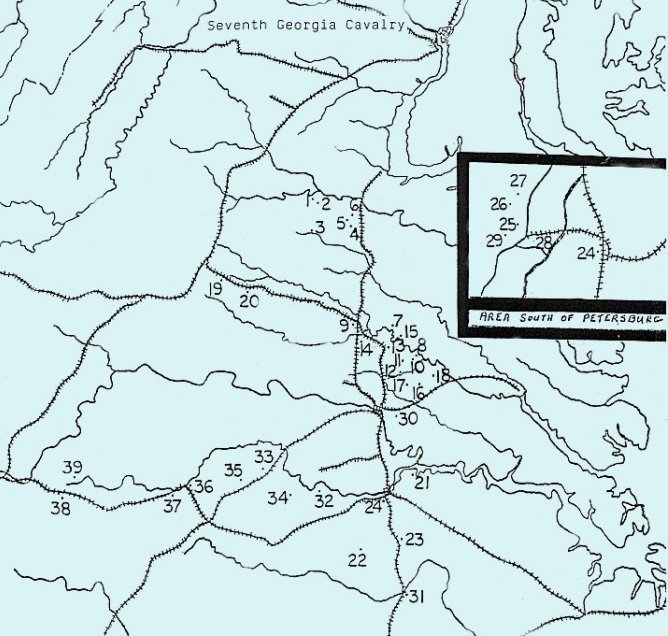|
Wiley William Waters, (my great great grand father), was born in Bullock County Georgia in January of 1824. At the outbreak of war in 1861 he was 37 years old. He was the third of five children born to John Dan Thomas Waters and Milly Green from Dobbs County, North Carolina who settled Cherokee land in Georgia in the early 1800's. He was married to the former Sarah Elizabeth (Sally) Grooms and they had five (5) children in their household. My great grand father, his son Wiley Hopkin was the youngest being only two years old at the time. William and Salley supported their family as independent farmers in Tattnall County Georgia and were not slaveholders.
Wiley William Waters volunteered to fight in April of 1862. He traveled from Tattnall County to Bryan County to enlist along with his older brother Bryant J. Waters,(40-42) and younger brother Berrian (Berry) F. Waters, (37), in the Hardwick Mounted Rifles which later became a part of the 7th Regiment of Georgia Cavalry.
The "7th Regiment, Georgia Cavalry" more commonly referred to as the "7th Georgia Cavalry" was formed at Savannah, Georgia by the consolidation of the 24th Battalion, Georgia Cavalry, four companies of the 21st Battalion, Georgia Cavalry and the two companies of the Hardwick Mounted Rifles, dated Feb. 13, 1864.
Hardwick Mounted Rifles
The "Hardwick Mounted Rifles" was formed in April of 1862 by Capt. Joseph L. McAllister in Bryan County, Georgia at Fort McAllister near his rice plantation, Strathy Hall.
The unit was named after the ghost town, "Hardwick", located between McAllister's Plantation and Fort McAllister. A former governor had planned to move the Georgia Capital from Savannah to this new settlement on the banks of the Ogeechee River. The name, Hardwick" came from an English friend of his, the Earl of Hardwicke. The project failed and Savannah remained the capitol.
The assignment and main objective of the Hardwick Mounted Rifles was to defend against Union invasion along the Georgia coast and protect the towns and homes of these Southeast Georgia coastal counties.
Their first significant encounter was with a landing party of Union soldiers at Kilkenny. There a local citizen, and quite an entrepreneur, who had quite a large "still". This was not a liquor still but one that extracted salt from ocean water. Salt at that time was in great demand and had a value around one dollar per pound. Regardless of why the Union chose this landing site, the newly organized men from Georgia defeated them.
The most outstanding encounter was that of the Union's seventh Naval Attack on Fort McAllister March 3, 1863. This was the most concentrated attempt the Union made using multiple Ironclads and three mortar boats. The battle raged for over seven hours with firing in both directions. Before the gun ships had moved into place, several men of the Hardwick Mounted Rifles crossed the Ogeechee and made their way through the marsh to within gun range of the ironclads. When the first Union sailor emerged, they opened fire, wounding him.
The mortar boats shelled the Battery all night on the 3rd with no damage. Only two men were injured during the entire attack and they had only minor injuries.
On the 4th, the Union boats left, convinced that a successful naval attack was not possible against Fort McAllister.
The efforts of the Fort McAllister Garrison and the Hardwick Mounted Rifles resulted in a victory for the Confederacy and much respect earned for both the Garrison and the Hardwick Mounted Rifles.
The early flag of the Hardwick Mounted Rifles was a Confederate Battle Flag without inscription. After the defense of Ft. McAllister against the Union ironcalds, Gen. Beauregard issued a special order for the unit to use the First National with the inscription "Fort McAllister" on it.




Even though the 7th was consolidated in February, the different battalions served independent of each other until May 1864. At that time they received new equipment and went to Augusta, then to Columbia, S.C. where they met Butler's Brigade. The entire 7th Georgia Cavalry rallied near Richmond in the latter days of May.
Waters, Wiley William GA Hardwick Mtd.Rifles Co.B ~ GA 7th Cav. Co.H
William Waters enlisted September 12, 1863 in Bryan County with J.L. McAllister. Pvt. Waters served in Co. B, Hardwick Mounted Rifles until, through consolidation of units, he was transferred to Co. H, 7th Regiment, Georgia Cavalry.
Waters was absent for a few days in late April '64 and on the May/June roll he was listed as being sick.
On April 9, 1865, Pvt. W.W. Waters surrendered at Appomattox Courthouse, Va. along with the remaining members of the 7th.
(Surrendered / paroled April 1865 Appomattox)

Private Bryant J. Waters
Waters, Bryant J. (John?) GA Hardwick Mtd.Rifles Co.B ~ GA 7th Cav. Co.H
B.J. Waters enlisted October 7, 1863 in Bryan County with Capt. Hines. Pvt. Waters served in Co. B, Hardwick Mounted Rifles until, through consolidation of units, he was transferred to Co. H, 7th Regiment, Georgia Cavalry.
Pvt. Waters was absent for 4 days in late April, just prior to moving to Northern Virginia. Afterwards he was present for the duration of the war.
On April 9, 1865, Pvt. B.J. Waters surrendered at Appomattox Courthouse, Va. along with the remaining members of the 7th.
(Surrendered / paroled April 9, 1865 Appomattox)
The company Captain was: Co. H, John P. Hines; From Co. B, "Hardwick Mounted Rifles".
Waters, Berrian (Berry) F.(Frank?) GA Cav. 21st Bn. Co.C ~ GA 7th Cav. Co.B
B.F. Waters enlisted December 9, 1863 at Georgetown, S.C. with Capt. Miller. Pvt. Waters served in Co. C, 21st Battalion, Georgia until, through consolidation of units, he was transferred to Co. B, 7th Regiment, Georgia Cavalry.
Pvt. Waters was captured June 11, 1864 during the Battle at Trevillian Station, Va. He was sent to Fortress Monroe, Va. on June 20th and on the 25th of July was transferred to Elmira Prison, N.Y. He was transferred for exchange October 11, 1864. The actual exchange took place on October 29th.
At the end of the war, he was paroled at Augusta on May 19, 1865.
The company Captain was: Co. B, Robert L. Miller; From Co. C, "Miller's Rangers".
The 7th was ordered to Virginia where it was assigned to The Army of Northern Virginia. It was re-assigned in late November 1864 to the Department of Richmond. It was soon returned to the Army of Northern Virginia and served there until the end of the war. The specific higher command assignments of the 7th Regiment, Georgia Cavalry are listed below.
|
May 1, 1864
August 31, 1864
October 31, 1864
November 30, 1864
January 31, 1865
|
Young's Brigade, Hampton's Division, Cavalry Corps, Army of Northern Virginia
Young's Brigade, Butler's Division, Cavalry Corps, Army of Northern Virginia
Young's Brigade, Hampton's (Old) Division, Cavalry Corps, Army of Northern Virginia
Gary's Brigade, Cavalry, Department of Richmond
Gary's Brigade, Fitzhugh Lee's Division, Cavalry Corps, Army of Northern Virginia
|
The Army of Northern Virginia's Order of Battle had the 7th Regiment, Georgia Cavalry scheduled at the Battle of Spottsylvania but it seems the 7th did not enter battle until June 11, 1864 at Trevillian Station. Col. William P. White the senior officer of the 7th did not lead the regiment to the front. He became the victim of an assassin's bullet. Col. White was succeeded in command by Lt. Col. Joseph L. McAllister. The 7th at this time, now at its peak with 842 men, was serving under Maj. Gnl. Wade Hampton.
Also in Hampton's Division were three other Georgia Calvary units, all veteran units; Cobb's Legion, Phillip's Legion and the 20th Battalion, Georgia Cavalry for a total force of slightly less than 5000.
After its arrival at Richmond, the 7th Georgia Cavalry joined the pursuit of General Phil Sheridan through the Shenandoah Valley. On the 11th of June, 1864 they were located between Trevillian Station and Louisa Court House. The 7th was not experienced in something as massive as the Battle of Trevillian Station, their first major encounter. The terrain in this area of Louisa County was very rough with very dense stands of timber and undergrowth, making it very difficult to maneuver. This was one of the bloodiest encounters of the war with tremendous losses on both sides totaling about 1600. Many of the 7th were killed the first day including Colonel Joseph McAllister being struck with 4 bullets in the chest and Capt. Whiteford D. Russell who was mortally wounded. The losses were not without reward. Union General Sheridan who had a starting force of about 8000, was pushed back, preventing him from joining Gnl. Hunter in his raid against Lynchburg, Va.
As dawn broke, the sound of gunfire roused the sleepy men of the 7th Georgia Cavalry. Hastily breaking camp, the men of the 7th Georgia stood to horse awaiting orders. About 6:00, the Georgians received orders to dismount and picket their horses near Trevillian Station, leaving a small guard with the animals.
One member of the regiment reported, “We were then marched to the scene of action, and I do truthfully say that I have never seen men go into a fight more willingly and more calmly than the 7th Georgia Cavalry.” He continued, “A smile lit up the countenance of every man from the right to the extreme left of the line.” Committed to the fight, the 7th Georgia led Wright’s counterattack, blunting the Federal advance.
A member of the 7th Georgia noted, “We drove them back in every charge, notwithstanding the advantageous ground which they were occupying. Their ranks were broken, and they fled precipitously. Soon, however, the rally was sounded, and having received large reinforcements, they charged us, numbering us nearly ten to our one. We contested every inch of ground with them, and even held them in check for a time.” “For four hours we fought alone, against fearful odds,” claimed a proud Georgian, “and I regret to state what the 7th suffered in killed, wounded and prisoners… You may judge how desperately we fought by our thin and decimated ranks. We carried six hundred men into the fight and brought out three hundred only.”
Lt. Col. Waring, commander of the Jeff Davis Legion, dismounted a “good many men to support General Butler.” As Waring’s command and the Georgians of the 20th Battalion of Georgia Cavalry pitched into the fray, so too did most of the men of the 7th Georgia Cavalry and Cobb’s Legion. The additional men made an immediate impact; Hampton later noted that “these two brigades pushed the enemy steadily back, and I hoped to effect a junction with Lee’s division at Clayton’s Store in a short time…”
The commander of the 7th Georgia, Lt. Col. Joseph McAllister, was a 43 year-old lawyer who had attended Amherst College. Although he had little military training, McAllister had natural ability to command men. His grandfather, Col. Richard McAllister, commanded a regiment of Pennsylvania infantry in George Washington’s Continental Army. Joseph McAllister was a wealthy and well-respected rice planter. He was “an upright, useful citizen, charitable to the poor and kind to all, a sagacious and dashing soldier, and a true patriot.” Trevillian Station was his first time leading troops in combat.
McAllister led the final counterattack of the Georgians along the Fredericksburg Road. Pitching into the fray, “shot and shell, canister and grape, mingled with the booming of artillery, made war’s grand chorus jeeringly sublime. But on, through the missiles of death, he bore himself as though he courted death in defense of his country’s liberties.” McAllister was completely surrounded by Yankee troopers. He cried out to his men, “Strike for God and our native land!”
A Yankee bullet struck him. Despite the pain, he emptied his revolver at the attacking Northerners, who demanded his surrender. The defiant McAllister threw the empty pistol at his attackers. He was then killed, four Yankee bullets in his chest.
McAllister’s boots and hat were taken and his stars and the buttons on his coat were cut from his uniform. Fortunately, his sword and spurs were recovered and returned to his family in Georgia.
Maj. Edward C. “Ned” Anderson, McAllister’s second in command, was wounded in the hip while leading a charge and was captured. Anderson hid his pocket watch and feigned that he could not walk as a result of the wounded hip. Later that day, he escaped and made his way back to the regiment the next day.
Three company commanders of the 7th Georgia were lost early on June 11: Capts. John P. Hines, A. R. Millar, and William D. Russell were killed. Capt. Frank W. Hopkins, commander of Co. G, was captured. Hopkins spent ten months at Fort Delaware and then joined the “Immortal 600”, a group of Confederate officers placed on a list for retaliation. These men were exposed to the fire of Confederate guns at Charleston, South Carolina. Hopkins survived his stint on the torture ships and eventually was freed from prison at Fort Pulaski at the end of the war.
Adam J. Iler, a 25 year-old second sergeant of the 7th Georgia, was captured that morning. A farmer from rural Georgia, Iler joined the McAllister’s company, the Hardwick Mounted Rifles, a local militia unit that became Company H of the 7th Georgia. Iler, who served for two years in the post-War Georgia legislature, fell into the hands of Torbert’s troopers during the fighting on the Fredericksburg Road. Iler’s war ended that day. He spent the duration as a prisoner of war in the infamous Northern prisoner of war camp at Elmira, New York.
Swooping down on largely defenseless wagons and horses, the 5th Michigan bagged several hundred prisoners, 1,500 horses, a stand of colors, 6 caissons, 40 ambulances, and 50 army wagons. Many Confederates broke their arms upon surrendering, rather than give them up. Others dropped their weapons until they realized that the 5th Michigan was unsupported. They then picked up their arms again and fired into the rear of the Wolverines.
The commotion in the rear alerted Butler. He sent some of his South Carolinians back toward the station to see what was going on in his rear. Their presence, combined with the 7th Georgia Cavalry dispatched by Hampton earlier to protect the wagon trains, bought valuable minutes. The 20th Georgia Cavalry of Wright’s command was also sent back to stem the tide.
In addition to the dead and wounded at Trevillian Station, about 180 men were captured and after a brief stay at Point Lookout Prison were transferred to Elmira Prison, N.Y. where most remained until the end of the war or died from the very harsh conditions.
Many of the 7th Georgia Cavalry were wounded and carried to Exchange Hotel (Gordonsville, Va. Receiving Hospital), now a museum.
Some survived and many did not.
In the month of June 1864 over 6000 wounded were brought to Gordonsville Receiving Hospital.
Gary's Brigade was reinforced by the 7th Georgia Cavalry for the second battle of Deep Bottom, August 16, 1864 after which they fought at Reams Station and the Weldon Railroad. Later, the 7th Ga. Cav. was officially transferred to Gary's Brigade. Also in Gary's Brigade were the 7th SC, Hampton's Legion and the 24th VA.
One of the many problems encountered by the 7th was that of maintaining healthy mounts. There was hardly a day that passed where the 7th did not encounter the enemy. With the cavalry being able to respond quickly, General Lee called upon them for reinforcement any time there was a threat anywhere along the Richmond line of defense. By December, most of the horses were dead or rendered useless from hard work and starvation.
In December 1864, Colonel E.C. Anderson, Jr. split the unit. The mounted part continued the fighting in Virginia and Col. Anderson left for Georgia with about 200 men to get fresh mounts.
When arriving in Georgia, they fought dismounted, defending Savannah against Union General Sherman's siege. When Savannah was evacuated, the dismounted men of the 7th, supporting General Young's command, were part of a defense line established about half way between Savannah and Charleston.
Most of these men were in NC when General Lee surrendered.
There were 39 enlisted men of the 7th Regiment, Georgia Cavalry who surrendered with General Robert E. Lee on April 9, 1865 at Appomattox. Others who had been separated from the unit and still nearby surrendered very soon thereafter. A few others were detailed with the wagon train and surrendered later.
The 7th Georgia Cavalry was the last unit to leave the burning ruins of Richmond.
Wiley William Waters survived the war and he and Salley had (5) five more children for a total of (10) ten. Salley died in 1874 and Wiley lived to the age of 76 dying August of 1900.

FOOT NOTES:
Encounters of the 7th Ga Cav
The 7th Georgia Cavalry was involved in a number of various type engagements during its history. These are listed below, each followed by a number which indicates a location on the map just below the list.
| Operation against Sheridan's Trevillian Raid,
Va. (19)
Engagement, Trevillian Station, Central R.R., Va. (19)
Action, Newark (Mallory's Cross Roads), Va. (20)
Siege Operations against Petersburg and Richmond, Va.(21)
...............
Engagement, Sappony Church (Stony Creek), Va. (22)
Engagement, Ream's Station, Va. (23)
Battle, Weldon R.R., Globe Tavern (Yellow House) and Black's Station (Six
Mile House), Va. (24)
Battle, Ream's Station, Va. (23)
Battle, Popular Springs Church (25),
..........Peeble's Farm (26),
..........Pegram's Farm (27), and
..........Laurel Hill (29), Va.
Engagement, Fair Oaks and Darbytown Road, Va.
Operations against Warren's Expedition to Hicksford, Va. (31)
Appomattox Campaign
Action, Namozine Church, Va. (32)
Skirmishes near Amelia Court House, Va. (33)
Skirmish, Tabernacle Church (Beaver Pond Creek), Va. (34)
Engagement, Amelia Springs, Va. (35)
Action, High Bridge, Va. (36)
Engagement, Farmville, Va. (37)
Engagement, Appomattox Station, Va. (38)
Engagement, Clover Hill, Appomattox Court House, Va. (39)
Surrender, Appomattox Court House, Va. (39)
|
June 7 - 24, 1864
June 11 - 12, 1864
June 12, 1864
June 26, 1864
April 2, 1865
June 28 - 29, 1864
June 29, 1864
August 18 - 21, 1864
August 25, 1864
......
......
......
Sept. 29 - Oct. 2, 1864
October 27 - 28, 1864
December 7 - 12, 1864
March 28 - April 9, 1865
April 3, 1865
April 4 - 5, 1865
April 4, 1865
April 5, 1865
April 6, 1865
April 7, 1865
April 8, 1865
April 9, 1865
April 9, 1865
|


|







